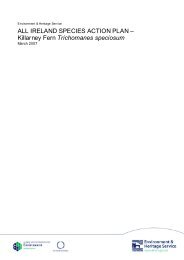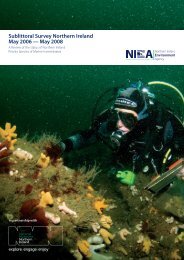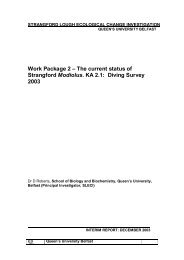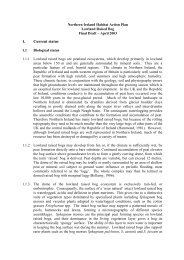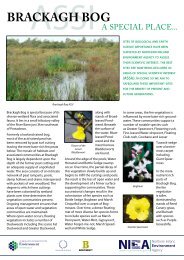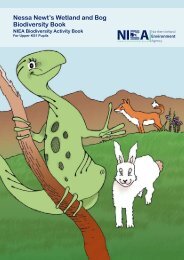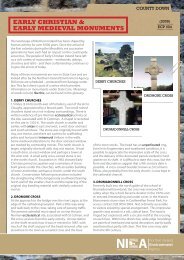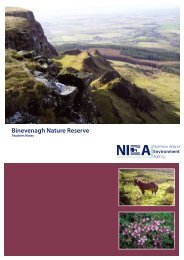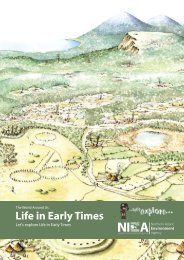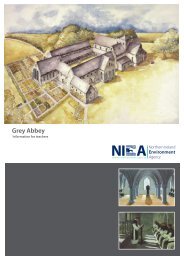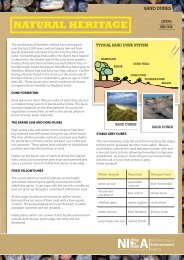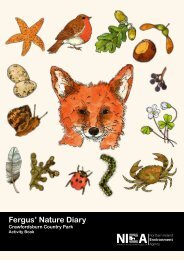NIEA Guidance Note On Active Peat
NIEA Guidance Note On Active Peat
NIEA Guidance Note On Active Peat
Create successful ePaper yourself
Turn your PDF publications into a flip-book with our unique Google optimized e-Paper software.
21/11/12<br />
<strong>NIEA</strong>, Natural Heritage, Development Management Team Advice <strong>Note</strong><br />
<strong>Active</strong> <strong>Peat</strong>land and PPS18<br />
This is an internal reference document to guide <strong>NIEA</strong> staff on the identification of active<br />
peatland in relation to PPS18. It is made available for the reference of developers and<br />
their agents and consultants preparing applications for renewables on peatland sites.<br />
<strong>Active</strong> peatland is one of a number of policy considerations that the planning authority<br />
uses when assessing wind energy applications.<br />
<strong>Peat</strong>land habitats are recognised as being important globally, nationally and locally.<br />
Our peatlands provide important ecosystem services including conserving biodiversity,<br />
carbon and water storage. They also give us some of our most distinctive landscapes.<br />
PPS18 has introduced a new policy for renewable energy whereby there shall be no<br />
development within active peatland unless there are imperative reasons of overriding<br />
public interest. The policy indicates that this includes blanket bog and raised bog. <strong>Active</strong><br />
blanket bog and raised bog are European priority habitats listed under Annex I of the<br />
Habitats Directive 92/43/EEC. We therefore have an international obligation to conserve<br />
these habitats.<br />
In terms of precisely defining these habitats, the key reference document is the European<br />
Commission's Interpretation Manual of European Union Habitats. Blanket bogs and raised<br />
bogs are European priority habitats if they are ‘active’. The manual defines active as to<br />
mean “still supporting a significant area of vegetation that is normally peat forming”. The<br />
term ‘active’, in relation to peatlands, therefore incorporates two main concepts –‘peat<br />
forming’ and ‘significant area’.<br />
<strong>On</strong> bogs peat may be formed by both Sphagnum mosses and cyperaceous species, such<br />
as cotton-grasses (Eriophorum angustifolium and E. vaginatum). The manual states that<br />
Sphagna play an important peat forming role in all bogs but in blanket bogs the<br />
cyperaceous component is greater than in raised bogs. The criterion in distinguishing<br />
between active and non-active bog is whether the surface is peat forming, rather than<br />
whether it has been cutover or not. Many secondary surfaces (i.e. cutover bogs) remain<br />
active.<br />
In uplands especially, active blanket bog can occur in a mosaic with inactive blanket bog<br />
and other upland habitats. Our bogs also show some regional variation from western<br />
regions to eastern regions. In areas of higher rainfall such as our western bogs and areas<br />
of higher elevation such as Garron Plateau, there are generally larger areas of Molinia<br />
flushes, which are a natural part of the blanket bog, than in those bogs in the east. Our<br />
eastern bogs generally contain a higher proportion of E. vaginatum rather than Sphagnum<br />
as the main peat former.<br />
1
Assessing <strong>Peat</strong>lands in relation to PPS18<br />
The following will help in decision making when deciding if an area is active or not.<br />
21/11/12<br />
You are more likely to be on active peatland if the site contains any of these indicators:<br />
Sphagnum is present<br />
If the surface is spongy underfoot<br />
Deep peat is present (>0.5m)<br />
Intact peat is present or the hydrology is still intact<br />
E. vaginatum/ angustifolium is present in significant quantities with some Sphagnum<br />
The typical range of blanket bog and raised bog species is present as indicated<br />
within the interpretation manual<br />
There is a hummock and pool topography<br />
You are less likely to be on active peatland if:<br />
None or very little Sphagnum is present<br />
A significant amount of non-typical bog community species is present as indicated<br />
within the interpretation manual e.g. soft rush<br />
There is a mosaic with acid grassland or dry heath<br />
<strong>Peat</strong> depth is less than 0.5m<br />
The surface is dry and / or the hydrology is severely affected by deep drains<br />
There are large areas of bare peat and / or algal mats<br />
Surveys necessary within an Environmental Impact Assessment (EIA) for a wind<br />
farm<br />
In order to establish if an area is active, detailed survey information will need to be<br />
provided. A Phase 1 survey describing the broad habitats should identify the peatland<br />
habitats present. Interpretation of aerial photos will help identify the broad areas before<br />
ground truthing. Each peatland unit should then have a more detailed vegetative<br />
assessment to National Vegetation Classification (NVC) level.<br />
NVC classifications are based on a detailed description of flora taken from systematic<br />
sampling of areas. The list below indicates the NVC classifications that could be active. In<br />
these habitats the full details of quadrats surveyed will be needed to aid identification of<br />
active peatland. They should be provided within the environmental statement (ES).<br />
NVC classifications which are likely to be found in active peatland:<br />
M1 Sphagnum auriculatum bog pool community<br />
M2 Sphagnum cuspidatum/recurvum bog pool communities<br />
M3 Eriophorum angustifolium bog pool community<br />
M17 Scirptus caespitosus- Eriophorum vaginatum blanket bog<br />
M18 Erica tetralix- Spagnum papillosum raised and blanket mire<br />
2
M19 Calluna vulgaris-Eriophorum vaginatum blanket mire<br />
M20 Eriophorum vaginatum blanket mire<br />
M25 Molinia caerulea-Potentilla erecta mire<br />
21/11/12<br />
The habitat units on site with any peat depth measurement greater than 0.5m should then<br />
be assessed in relation to active peatland. It would be useful for developers to apply the<br />
methodology below when identifying active peatland and provide the quadrat details within<br />
their ES.<br />
Survey methodology for <strong>NIEA</strong> site visit<br />
For each habitat unit, take a random sample of 2X2m quadrats. The number of quadrats<br />
needed depends on the area to be sampled. A good working measure is one per hectare<br />
though for large areas of homogenous habitat (approximately >20 hectares) this could be<br />
reduced to one per two - five hectares depending on the size of the unit. In addition include<br />
quadrats in locations which are to be developed.<br />
For each quadrat note the following:<br />
List of species and domin cover for each<br />
% cover of each Sphagnum spp./E. vaginatum/E. angustifolium and total % cover of<br />
these species<br />
% cover of any non-typical species if present<br />
Area of bare peat and algal mats<br />
Depth of peat<br />
If the peat is intact or has evidence of modifications<br />
All the quadrat results for each habitat unit should be considered together to form a picture<br />
of the quality of the whole habitat unit and whether, in its entirety, it is an active peatland.<br />
Blanket bog envelops a landscape and may include areas of blanket bog, wet heath, dry<br />
heath, flushes, upland fen, acid grasslands and ponds which are a natural component of<br />
peatland habitats. The European Commission’s (EC) interpretation of active peatland is “a<br />
significant area of peat forming vegetation” and therefore recognises the mosaic of<br />
habitats that can occur within blanket bog. The large hydrological peat units on a<br />
mountainside must therefore be considered as part of the decision making process. If a<br />
survey finds small isolated pockets of active peat, such as in drains, then the unit would<br />
not be considered to be active. However if larger areas of active peat are identified with<br />
smaller areas of inactive peatland, this would indicate that the hydrological unit is mainly<br />
active. In these cases impacts to inactive areas could indirectly impact on adjacent active<br />
areas due to introduced hydrological changes. We will consider the unit to be classified as<br />
active.<br />
In relation to single turbines, an assessment of the peatland unit(s) where the turbine and<br />
access road are to be located needs to be undertaken. Quadrats as detailed above should<br />
suffice after aerial identification of the peatland units. For more complicated or extensive<br />
sites Phase 1 and NVC surveys and peat depths may need to be requested from the<br />
applicant.<br />
3
Temporarily inactive peatland<br />
The EC Interpretation Manual of European Union Habitats says:<br />
21/11/12<br />
“The term ’active’ must be taken to mean still supporting a significant area of vegetation<br />
that is normally peat forming, but bogs where active peat formation is temporarily at a<br />
standstill, such as after a fire or during a natural climatic cycle e.g., a period of drought, are<br />
also included.”<br />
Therefore peatland that has been burnt or otherwise damaged, but where it is believed<br />
that peat formation has only ceased temporarily, also comes within the definition of active.<br />
In addition different parts of a blanket bog can be active at different stages, even over very<br />
long periods of time, depending on topographic and climatic variables as well as<br />
anthropogenic factors.<br />
Burning generally has a temporary impact on an active peatland. Where this has occurred,<br />
the remnants of the vegetation should be investigated as Sphagnum hummocks are<br />
usually still evident after a burn. Where present it shall be presumed that the site was<br />
active and is therefore likely to return to such in a short time period. The area adjacent to<br />
the burnt area may also help distinguish if the peat mass was active. Auger cutting is also<br />
considered to only have a temporary impact.<br />
Compensation and restoration<br />
Where the quality and/or extent indicates that the peatland unit is not active, the peatland<br />
area could be considered for compensatory or restoration measures.<br />
Both PPS18 and the European Commision’s Manual of European Union Habitats refer to<br />
compensatory measures and/or appropriate rehabilitation management. Policy RE1 refers<br />
on pages 8, 10 and 11 to mitigation and compensatory measures. Paragraph 4.11 in<br />
particular indicates the potential to restore negatively impacted peat to active peatland.<br />
The Interpretation Manual of European Union Habitats refers to the repair of the hydrology<br />
of bogs through appropriate rehabilitation management for raised bogs. Where proposals<br />
are under consideration that include compensatory measures and/or appropriate<br />
rehabilitation management sufficient details should be provided to allow an assessment of<br />
the potential net effect of the overall development on peat habitats outside the active<br />
peatland area. In the event that such interventions produce a situation of no long term<br />
biodiversity loss, the <strong>NIEA</strong> consultation response will comment accordingly in the context<br />
of PPS18 policy RE1.<br />
Further Advice<br />
For further advice or discussion contact:<br />
Claire Hempsey, <strong>NIEA</strong>, Natural Heritage: 02890569827<br />
Claire.hempsey@doeni.gov.uk<br />
4



